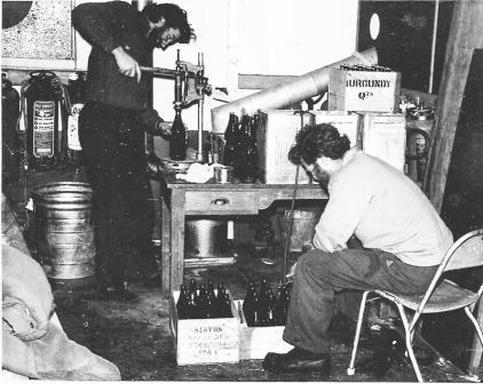- AGM - General Information
- AGM - Nominating for Council
- Message from the Club President
- About Our Club
- Club Management
- Our Branches
- Family & Friends Association
- Introduction to the Site
- News and Upcoming Events
- Melbourne MWD 2012 Images
- UK/Europe MWL 2012
- Photos from some Recent pre-2012 Dinners
- Nomination Form
- 2011 Medal Recipient
- Introduction
- Melbourne
- New South Wales
- Northern Territory
- Queensland
- South Australia
- Tasmania
- Links to Official Sites
- Links to Personal Pages
-
Gallery and Sound Bites
- Obituaries and Member Tributes
- Shelagh Robinson
- Alf Howard
- Dr Phil Law
- Classified Ads and Similar
- Gallery and Sound Bites
- Macquarie Island Field huts
- Brewing beer on station
- Masons Hut in miniature
Stories about Brewing Beer at the Stations
Beer has been brewed at the Antarctic stations for many years; sending commercially packaged beer down south takes up valuable cargo space, thus it is more efficient to send limited quantities and brew the majority on-station.
The empty commercial beer bottles are refilled with the home brew - commonly called "Homers".
In the past, the homers was made from the basic ingredients - yeast, a starter from previous brews, malt and the usual ingredients. Nowadays, commercial home brew kits are used.
Bottling nights are a social event at the stations and many people, including non-drinkers attend.
Here are some stories about brewing beer at the stations.
The empty commercial beer bottles are refilled with the home brew - commonly called "Homers".
In the past, the homers was made from the basic ingredients - yeast, a starter from previous brews, malt and the usual ingredients. Nowadays, commercial home brew kits are used.
Bottling nights are a social event at the stations and many people, including non-drinkers attend.
Here are some stories about brewing beer at the stations.
Mawson 1959

Bottling Home Brew, Biscoe Hut Mawson. Photo by Grahame Budd
I had brought the recipe from Heard Island, where in 1954 it had been known as ‘Azorella juice’. But my grateful patients at Mawson had produced the poster seen on the door, which celebrated its virtues and ended with the punch-line “Your doctor will tell you - it’s good for you!”
The figures, left to right, are ionospherics physicist Ross Dunlop and senior meteorologist Ian Widdows, who earlier in the year had had a retrocaecal appendix removed while lying on one of the mess tables and (being a tall sort of chap) the sewing machine.
My most popular medical decision of the year was when exploding homebrew bottles on a shelf in the kitchen had obliged me to declare a Public Health Emergency, requiring that the hazard be removed forthwith by emptying the bottles in an appropriate manner.
Compliance, I’m happy to report, was 100%.
Grahame Budd.
The figures, left to right, are ionospherics physicist Ross Dunlop and senior meteorologist Ian Widdows, who earlier in the year had had a retrocaecal appendix removed while lying on one of the mess tables and (being a tall sort of chap) the sewing machine.
My most popular medical decision of the year was when exploding homebrew bottles on a shelf in the kitchen had obliged me to declare a Public Health Emergency, requiring that the hazard be removed forthwith by emptying the bottles in an appropriate manner.
Compliance, I’m happy to report, was 100%.
Grahame Budd.
Mawson 1966

Photo by John Le Quiniat
